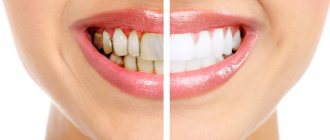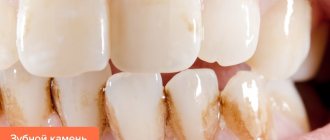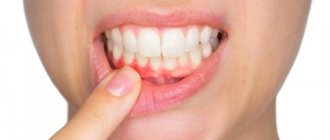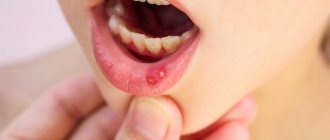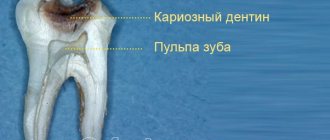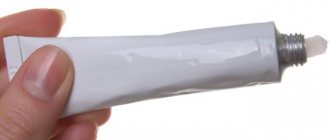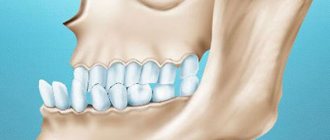The main causes of tartar formation
Tartar in children is formed mainly as a result of poor daily oral hygiene, as well as due to:
- lack of hard and solid foods in the diet;
- the absence of a special protein in the baby’s saliva, which helps slow down the proliferation of crystals;
- lack of a special substance pyrophosphate in the body, which significantly slows down the development of dental plaque;
- unlimited consumption of carbohydrate and sugar-containing foods;
- saliva viscosity;
- malocclusion, crowding of primary teeth.
If you find signs of tartar in your child, immediately contact a dental clinic, as independent and unprofessional treatment can lead to serious consequences.
Kinds
Based on localization, there are two types of tartar: supragingival and subgingival.
Supragingival
Supragingival deposits are clearly visible because they are located above the level of the gums. They often have a yellowish tint, which can be darker if a person abuses smoking and taking coloring products.
The density of plaque depends on the duration of its stay on the tooth surface. Supragingival stone is formed as a result of the activity of microorganisms.
Subgingival
Subgingival formations are invisible to the naked eye. They can only be detected by dentists through a periodontal examination.
They are located under the gum tissue in the area of periodontal pockets. These deposits contain magnesium and calcium phosphate.
For information about the causes of formation, symptoms and types of tartar, watch the video.
Treatment of tartar in children
At your first appointment with the dentist, the doctor will conduct an initial examination, with the help of which he will determine the degree of development of tartar, identify its main cause and draw up a further treatment plan.
Deposit removal is usually carried out in several stages:
- Professional hygienic cleaning, during which all plaque and deposits are removed. For children, this stage takes place under local anesthesia using an ultrasound device.
- Fluoridation is a procedure that permanently prevents further formation of tartar on teeth.
- Checking the cleanliness index.
- Consultation and advice for parents on caring for their baby’s oral cavity.
- Repeated appointment after 2 weeks to monitor the effectiveness of the procedure.
Formation process
The formation of tartar is a fairly long process, going through several successive stages:
- After eating, tiny particles of food remain on the surface of the enamel, which become a haven for pathogenic microorganisms.
As a result of their vital activity, enzymes are produced, which contributes to the formation of soft plaque and its fixation on the surface of the teeth. Most often, soft deposits are located along the gum line. With timely cleaning they can be easily removed. - The lack of hygiene procedures leads to the fact that the plaque is gradually saturated with salts and mineral components that are present in saliva.
It becomes more difficult to completely remove it. During subsequent meals, the smallest particles of food, together with waste products of bacteria, accumulate on existing layers. Mineralization of deposits occurs, they harden, increase in volume and acquire a yellowish-brown or gray tint.
The rate of formation of tartar depends on the quality of hygiene procedures, the composition of saliva and the human diet. On average, the process takes about 4-6 months.
Hardened deposits cannot be removed with a toothbrush and toothpaste. In addition to the fact that they do not look aesthetically pleasing, such stones can lead to the development of dental diseases.
Composition and action of mouth rinse SV 12, its effectiveness. Find reviews of orthodontic trainers here.
Follow the link https://dr-zubov.ru/ortodontiya/apparaty/kappy/osobennosti-i-preimushhestva-vyravnivaniya.html to see a photo of a mouthguard for straightening teeth.
Preventive actions
To prevent the re-formation of tartar, parents should teach their child to brush their teeth correctly and thoroughly. Important factors in prevention are the choice of the right toothpaste, which contains pyrophosphate, as well as a correctly selected toothbrush with artificial bristles, in which the proliferation of microorganisms is least likely. It should be changed at least once every 3 months. The hygiene of the tongue, cheeks and palate should also be given special attention, as this is an ideal place for bacteria to accumulate.
Regular visits to the dental office will significantly reduce the likelihood of developing tartar in children. At the Sanident dental clinic, specialists provide dental treatment not only for adults, but also for children. Our dentists take into account age characteristics and carry out all procedures in accordance with the specifics of the child’s body.
Dental clinic "Sanident" is located in Shchelkovo at the address: Tsentralnaya str., no. 80.
Causes of plaque
Tartar in most cases occurs under the influence of local factors. Some of the most striking reasons for the formation of plaque in children include non-compliance with oral hygiene rules and a lack of solid foods in the daily diet. In addition, the cause of plaque in large quantities may be the absence or deficiency of pyrophosphate in the baby’s saliva. This substance can slow down the development of various types of deposits on teeth. The appearance of tartar may also indicate an insufficient amount of a particular protein in the saliva of a small patient that can inhibit the growth of crystalline deposits.
It is not always possible to recognize the presence of tartar on a child’s teeth. This is explained by the fact that the surface of the tooth enamel and the calcium phosphate crystals are closely connected, and this, in turn, complicates the recognition of the boundary between the beginning of the tartar and the end of the enamel.
Types of tartar
In dentistry, there are only two types of tartar, which are recognized by their location on the teeth:
- supragingival
- subgingival.
Supragingival tartar is usually gray or white-yellow in color. It can be seen with the naked eye and can be easily removed by scraping. The formation of supragingival tartar occurs due to the deposition of minerals that come from saliva. In most cases, the localization of this type of stone is in the areas of the frontal teeth of the lower jaw and upper molars (buccal surfaces), where the ducts of the glands that form saliva are located.
Regarding subgingival tartar, it is more difficult to recognize. Only a dentist can do this with probing. Subgingival tartar is formed due to mineral deposits, which come mainly from the gingival fluid. Places of its localization: tooth neck, root cement, periodontal pocket. In most cases, plaque is firmly attached to the tooth surface, covering the neck and forming protrusions. Subgingival stone is dark brown and has a greenish tint.
A child has tartar – what to do?
If you have discovered tartar on your child’s teeth, then first of all, make an appointment with a pediatric dentist. Tartar removal will be performed in two steps. At the first appointment, the little patient will have a professional teeth cleaning. With its help, soft plaque and deposits on the teeth will be removed. Subgingival tartar is removed under local anesthesia using ultrasound. As a rule, after such procedures, the pediatric dentist explains to the little patient how to properly brush his teeth and care for the oral cavity, and asks his parents to supervise the procedures. The second appointment is scheduled a couple of weeks later. At the second visit to a specialist, the thoroughness of the previously removed tartar and deposits is monitored.
Tartar in children: prevention
Among the reasons listed above for the formation of tartar, the absence of pyrophosphate in the child’s saliva was noted. And to prevent the formation of plaque on your teeth, you can use special toothpastes that contain this component. This will help not only stop the process of mineralization of stone on the teeth, but also prevent the growth of a new layer. Thus, the pyrophosphate contained in the paste, in some way, replaces the natural analogue if it is not present in the child’s saliva. However, when choosing a toothpaste with this component, be sure to take into account the appropriate age category.
The toothbrush plays an important role in the formation of tartar. Choosing the right toothbrush for your child will help prevent new growths. When choosing a brush to clean children's teeth, it is necessary to give preference to artificial bristles, since bacteria and microorganisms can form in natural bristles. At the same time, do not forget that experts recommend changing brushes once every 3 months, at least.
To prevent the formation of tartar in the youngest patients who cannot yet brush their teeth on their own, you can use special wipes. They contain xylitol, which can inhibit the development of bacteria in the oral cavity. By wiping the surface of your child’s teeth with these napkins, you can also clean them of soft plaque.
In order to maintain proper oral hygiene, it is necessary to teach your child the basic rules. According to the basic recommendations of pediatric dentists, you should first brush the teeth of the upper jaw with brush movements from top to bottom, starting in the lateral sections and smoothly moving to the front. In the same sequence, it is necessary to manipulate the toothbrush when brushing the lower teeth, moving it from bottom to top. At the same time, do not forget to pay attention to the hygiene of the mucous membranes of the tongue, cheeks, and palate, because bacteria can form on them too.
Among other things, it is worth diversifying the children's menu by adding more solid foods to it. An excellent option would be fresh carrots, apples, cabbage and others.
Note to parents
Parents should regularly monitor their child’s oral hygiene. To prevent the formation of tartar, it is worth taking your child to the pediatric dentist. This will allow pathology to be detected in time so that it does not cause the development of diseases (periodontitis, gingivitis, stomatitis, etc.) in the child’s oral cavity. In addition, the child will not have problems associated with bad breath. Visits to the dentist will allow you to timely provide the necessary care to your teeth with braces installed on them.
And remember that only a pediatric dentist who uses an individual approach and a special set of professional tools and products can remove tartar and mineralized plaque.
Tags: Cleaning

